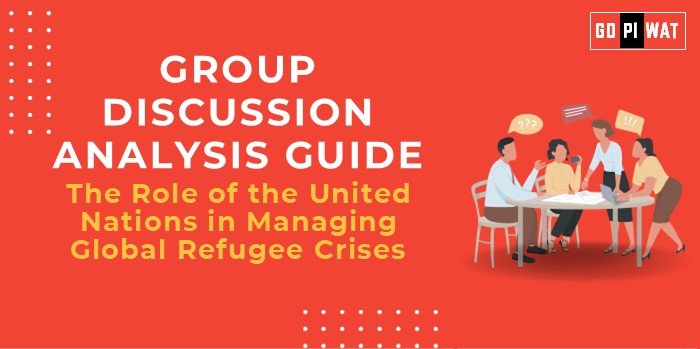📋 Group Discussion Analysis Guide: The Role of the United Nations in Managing Global Refugee Crises
🌐 Introduction to the Topic
- 📌 Opening Context: The global refugee crisis has reached unprecedented levels, with over 35 million refugees worldwide as of 2023 (UNHCR). The United Nations (UN) plays a critical role in coordinating international efforts to address the needs of displaced populations, ensuring their safety, dignity, and basic rights.
- 📖 Topic Background: The UN’s involvement in managing refugee crises began with the establishment of the United Nations High Commissioner for Refugees (UNHCR) in 1950. Its mandate has since expanded to include emergency assistance, resettlement programs, and advocating for long-term solutions. Despite its efforts, the growing scale of displacement due to conflicts, climate change, and persecution highlights the need for robust international collaboration.
📊 Quick Facts and Key Statistics
🌍 Global Refugee Population: 35.3 million in 2023 (UNHCR).
💰 UNHCR Budget: $10.3 billion for 2024; funding gap persists at 45%.
⚠️ Major Crisis Regions: Syria, Afghanistan, Venezuela, South Sudan, and Ukraine.
🏠 Resettlement Statistics: Only 0.6% of refugees resettled globally in 2022.
🌍 Climate Displacement: 20.7 million displaced due to natural disasters in 2023.
💰 UNHCR Budget: $10.3 billion for 2024; funding gap persists at 45%.
⚠️ Major Crisis Regions: Syria, Afghanistan, Venezuela, South Sudan, and Ukraine.
🏠 Resettlement Statistics: Only 0.6% of refugees resettled globally in 2022.
🌍 Climate Displacement: 20.7 million displaced due to natural disasters in 2023.
👥 Stakeholders and Their Roles
- 🏛️ United Nations (UNHCR, UNDP): Coordination, advocacy, and resource mobilization for refugee assistance and resettlement.
- 🌍 Host Countries: Provide asylum and integration programs; manage local impacts of refugee inflows.
- 💰 Donor Nations: Financially support refugee operations and aid programs.
- 🌱 NGOs and Civil Society: Deliver on-ground services like healthcare, education, and legal aid.
- 🤝 Refugees: Play an active role in rebuilding lives and integrating into host communities.
🏆 Achievements and Challenges
✨ Achievements:
- 🚨 Emergency Response Mechanisms: UNHCR deployed resources to assist over 15 million refugees in 2023.
- 🌍 Resettlement Programs: Global initiatives provided safe havens for over 125,000 refugees in 2022.
- 🤝 Global Compact on Refugees (2018): Enhanced responsibility-sharing and sustainable solutions.
- 📚 Advocacy for Inclusion: Integration of refugees into education and employment programs in host countries.
⚠️ Challenges:
- 💰 Resource Constraints: Persistent funding gaps hinder effective operations.
- 🚫 Political Resistance: Host countries face rising anti-refugee sentiments and policy restrictions.
- 🌍 Climate Displacement: Lack of a robust international framework to address environmentally displaced populations.
🌍 Global Comparisons:
- ✔️ Success: Canada resettled 45,000 refugees in 2022, setting a global example.
- ❌ Challenge: Lebanon, hosting over 1 million Syrian refugees, struggles with resource scarcity.
📢 Structured Arguments for Discussion
- ✅ Supporting Stance: “The UN provides critical frameworks and resources, ensuring global accountability and shared responsibility in refugee management.”
- ❌ Opposing Stance: “Despite its mandate, the UN’s efforts are often limited by funding shortfalls and lack of enforcement power over member states.”
- ⚖️ Balanced Perspective: “While the UN plays a pivotal role, the success of refugee management depends on enhanced international cooperation and equitable burden-sharing.”
🧠 Effective Discussion Approaches
- 🎯 Opening Approaches:
- Data-Driven Start: “With 35 million refugees worldwide, the UN’s role is more critical than ever in addressing this humanitarian crisis.”
- Case Study Focus: “The Syrian refugee crisis demonstrates both the UN’s capacity for large-scale response and the limitations imposed by resource constraints.”
- 🤝 Counter-Argument Handling:
- Recognize valid criticisms (e.g., resource gaps) while emphasizing potential solutions such as donor commitments or improved frameworks like the Global Compact.
📊 Strategic Analysis of Strengths and Weaknesses
- Strengths:
- Global reach, established frameworks, emergency response capacity.
- Weaknesses:
- Funding gaps, political constraints, reliance on host nations.
- 📈 Opportunities: Expanding public-private partnerships, addressing climate-induced displacement.
- ⚡ Threats: Rising nationalism, donor fatigue, geopolitical conflicts.
🎓 Connecting with B-School Applications
- 💼 Real-World Applications: Explore sustainable financing for refugee programs (e.g., social impact bonds).
- 📚 Sample Interview Questions:
- “How can the UN address the growing funding gaps in refugee assistance programs?”
- “Evaluate the impact of private sector partnerships in managing refugee crises.”
- 💡 Insights for B-School Students:
- Use refugee management as a case study for leadership in crisis management.
- Analyze frameworks like the Global Compact to understand global governance mechanisms.


